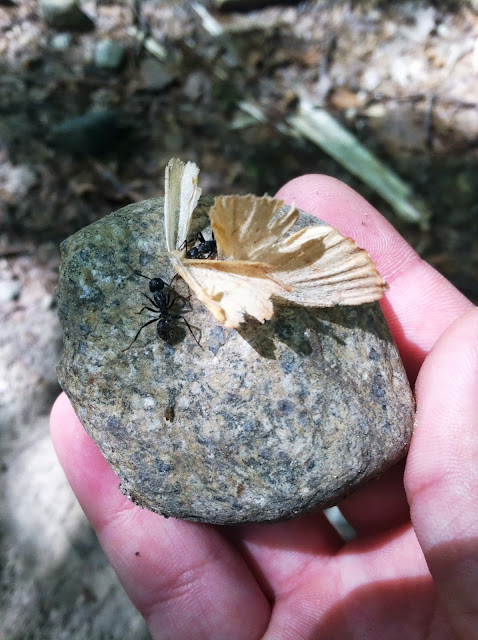This is a sea-urchin, which belongs to the phylum Echinodermata. Echinoderms are classified by their spiny or prickly skin (echino-prickly, derma-skin) and are noted for having radial symmetry and internal calcareous (chalky) skeletons. Another characteristic of many echinoderms are "tube feet", which are suction-powered feet caused by internal water-filled canals. This specific sea-urchin has been dead for years and has lost most of its spines. Echinodermata is also the largest phylum exclusive to marine animals and include sea-stars, sea-cucumbers, and sand dollars.
Shells are usually the exoskeleton created by invertebrates such as mollusks, cephalopods, bivalves, gastropods, etc., although, animals such as hermit crabs are incapable of creating their own shell, so they make home in a vacant shell left behind by a shell-creating creature. Shells are most often composed of calcium carbonate, like egg-shells, and have a chalky texture.
Above is a honeybee extracting pollen and nectar from a french marigold. By doing so, it is assisting in pollination, therefore being a pollinator. French marigolds are hermaphroditic, thus able to self-pollinate, meaning that this specific honeybee could possibly have pollinated this specific marigold by rustling the pollen around until some had come in contact with some of the plant's stigmas, allowing self-fertilization to occur. It could have also retained pollen residue on its body and pollinated a different marigold.
This picture consists of two different types of fungi. The kingdom Fungi consists of yeasts, molds, mushrooms, etc. Many fungi are deathly poisonous, while others are edible and sometimes even hallucinogenic. Fungi are usually asexual and reproduce via sporulation. Certain fungi can also be found bonded to an alga in the form of a lichen, where the fungus is called the mycobiont and the alga the photobiont and the two live symbiotically.
This is a frog that I stumbled upon in Vermont. Frogs, along with salamanders, newts, caecilians, axolotls, etc., are amphibians, belonging to the class Amphibidia. Amphibians are the descendants of the first vertebrates that made the transition from life on water to life on land and are characterized by having smooth skin, being cold-blooded, and being able to sustain life in both aqueous and non-aqueous environments. Most amphibians undergo metamorphosis and spawn in the water. A frog starts its life as an egg, hatches as a tadpole, and eventually morphs into its adult stage.
This is a picture of a spider that I also found in Vermont. Spiders belong to the class Arachnidia. Arachnids are invertebrates with eight jointed legs and include ticks, mites, scorpions, etc. They are usually predacious and often times, poisonous. Anatomically, arachnids consist of a cephalothorax, where the sensory organs, mouthparts, and limbs are located, and abdomen, where reproductive parts, and spinnerets in spiders, can be found. Spiders are famed for creating webs made of silk that they can travel across, trap prey, and wrap prey or eggs in.
This is the eye of a blue eyed girl. The blue part of the eye surrounding the pupil is called the iris. The iris generally consists of the stroma, dilator muscle, and sphinctor muscle. The stroma is the outermost layer of the iris and can contain pigmentation, although, this specific eye lacks pigment, which is responsible for the blue coloration. The dilator muscle is what increases the size of the pupil, allowing more light to enter, and the sphinctor does the opposite.
These are two ants scavenging moth wings. Scavengers are any creature that feeds on animal corpses and other remains. Herbivores, carnivores, and omnivores can all be scavengers, although certain creatures mainly rely on predation. When live food is scarce, animals like foxes resort to scavenging for food. What's left behind by scavengers is usually taken care of by the detritivores who recycle the corpse' nutrients back into the soil.








1 comment:
Great photos - do you know the type of frog from VT?
Post a Comment